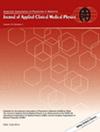Comparative assessment and QA measurement array validation of Monte Carlo and Collapsed Cone dose algorithms for small fields and clinical treatment plans
Abstract
Purpose
Many studies have demonstrated superior performance of Monte Carlo (MC) over type B algorithms in heterogeneous structures. However, even in homogeneous media, MC dose simulations should outperform type B algorithms in situations of electronic disequilibrium, such as small and highly modulated fields.
Our study compares MC and Collapsed Cone (CC) dose algorithms in RayStation 12A. Under consideration are 6 MV and 6 MV flattening filter-free (FFF) photon beams, relevant for VMAT plans such as head-and-neck and stereotactic lung treatments with heterogeneities, as well as plans for multiple brain metastases in one isocenter, involving highly modulated small fields. We aim to investigate collimator angle dependence of small fields and performance differences between different combinations of ArcCHECK configuration and dose algorithm.
Methods
Several verification tests were performed, ranging from simple rectangular fields to highly modulated clinical plans. To evaluate and compare the performance of the models, the agreements between calculation and measurement are compared between MC and CC. Measurements include water tank measurements for test fields, ArcCHECK measurements for test fields and VMAT plans, and film dosimetry for small fields.
Results and conclusions
In very small or narrow fields, our measurements reveal a strong dependency of dose output to collimator angle for VersaHD with Agility MLC, reproduced by both dose algorithms.
ArcCHECK results highlight a suboptimal agreement between measurements and MC calculations for simple rectangular fields when using inhomogeneous ArcCHECK images. Therefore, we advocate for the use of homogeneous phantom images, particularly for static fields, in ArcCHECK verification with MC.
MC might offer performance benefits for more modulated treatment fields. In ArcCHECK results for clinical plans, MC performed comparable to CC for 6 MV. For 6 MV FFF and the preferred homogeneous phantom image, MC resulted in consistently better results (13%–64% lower mean gamma index) compared to CC.


 求助内容:
求助内容: 应助结果提醒方式:
应助结果提醒方式:


